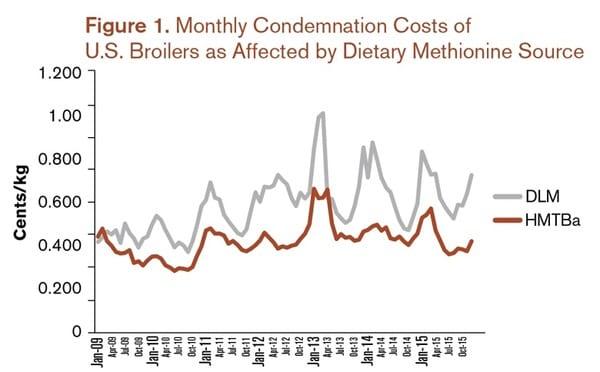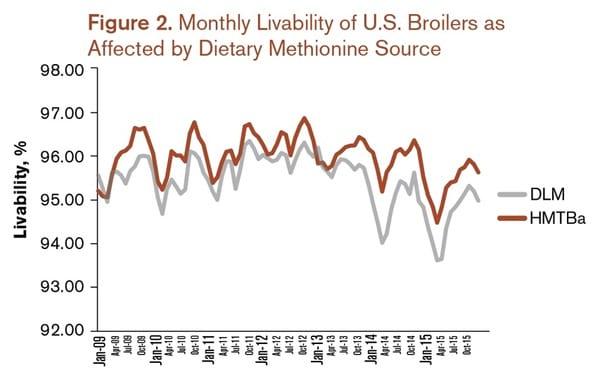Minimize Condemnations: Protect Profits Through Supplementation of HMTBa
Published: October 27, 2017
By: Fenglan Yan, Ph.D., Research Sr. Scientist, Poultry Nutrition – Novus International, Inc.
Recent data has shown broilers supplemented with HMTBa (2-hydroxy 4-(methylthio) butanoic acid) as a methionine source exhibited fewer condemnations and higher livability consistently. Broiler producers know that to achieve their best profit margins, every aspect of the process from live production to processing must be optimized, but many producers find that even through careful management, condemnations cut their profits time after time. Producers and animal scientists have been seeking effective ways to combat condemned birds for decades, and HMTBa could support these reduction efforts. HMTBa (sold as ALIMET® feed supplement) could be an economical option for many producers to maximize their production efficiency and profitability by minimizing condemnations and helping to improve livability.
Broiler Condemnations
With narrow industry margins and a shift away from in-feed antibiotic use for growth promotion and disease prevention, producers are investing in greater protection from condemned birds. Total or partial carcass condemnation can cause significant economic loss across the supply chain, limiting opportunities for business expansion and growth long term. There are several general reasons for birds to be declared condemned at processing including disease, bruising, tumors, contamination and over-scalding. Among these, several are health related such as disease and tumors, and could be at least partially addressed by nutrition management.
Broiler Condemnations
With narrow industry margins and a shift away from in-feed antibiotic use for growth promotion and disease prevention, producers are investing in greater protection from condemned birds. Total or partial carcass condemnation can cause significant economic loss across the supply chain, limiting opportunities for business expansion and growth long term. There are several general reasons for birds to be declared condemned at processing including disease, bruising, tumors, contamination and over-scalding. Among these, several are health related such as disease and tumors, and could be at least partially addressed by nutrition management.
In the U.S. broiler industry for example, septicemia/toxemia is one of the most common causes of condemnation and occurs when bacteria enter the bloodstream causing systemic changes within the bird. Airsacculitis is also a leading cause of condemnation that stems from environmental stressors like improper temperatures, water management, litter management or low air quality. This disease causes virus-like symptoms and respiratory distress. Inflammatory process is another disease that can lead to condemnation. This refers to inflammation of connective tissue with severe inflammation of the dermal and subcutaneous layers of the skin due to bacterial infection. As a naturally occurring methionine precursor, HMTBa is an organic acid, making it easy to be absorbed and available for use by the animal. Because HMTBa is an organic acid with a pH of less than 1, it can lower bacteria and mold load during feed storage and support better gut health in vivo. This, in turn, helps lower the incidence of these infectious diseases, which can reduce costly condemnations.
Different Acids, Different Results
Data from an independent industry benchmarking organization was evaluated for differences between carcass performance and condemnations between birds fed two different methionine sources, DL-methionine and HMTBa. All data available to the benchmarking organization were included, which covered 50 billion broilers from 2009 to 2015, representing the majority of broilers raised in the United States during this period. Among the 50 billion broilers raised, 38 billion were fed HMTBa supplemented diets and 12 billion were fed DL-methionine supplemented diets. While both provide methionine activity, each has a different chemical structure which affects the end result of supplementation in performance, including effects on condemnations and livability.
Different Acids, Different Results
Data from an independent industry benchmarking organization was evaluated for differences between carcass performance and condemnations between birds fed two different methionine sources, DL-methionine and HMTBa. All data available to the benchmarking organization were included, which covered 50 billion broilers from 2009 to 2015, representing the majority of broilers raised in the United States during this period. Among the 50 billion broilers raised, 38 billion were fed HMTBa supplemented diets and 12 billion were fed DL-methionine supplemented diets. While both provide methionine activity, each has a different chemical structure which affects the end result of supplementation in performance, including effects on condemnations and livability.
The data showed economic loss due to condemnation of approximately $0.11 USD per kilogram lower for birds fed HMTBa when compared with DL-methionine supplementation (Figure 1). The economic value would be more than $3,000 per one million birds with an average body weight of 2.77 kg, as reported in the data. The savings is greater in heavier birds, which have been the market trend in recent years. For the 38 billion HMTBa-fed birds included in the data, this equals a savings of $115.8 million in condemnation reduction.


Known as the standard measure for poultry that not only indicates what percent of the flock survives, but also serves as an indicator of profitability for the producer, livability is a key indicator of a supplement’s effectiveness. This data concluded that birds with HMTBa supplemented rations had consistently higher livability compared to those fed DL-methionine over the course of five years (Figure 2). The increased livability was worth approximately $0.06 per kilogram or $63.2 million for the 38 billion HMTBa supplemented birds, giving even greater peace of mind to the producer that his investments will reap returns.

As methionine is the first limiting amino acid in poultry, birds can’t grow efficiently without adequate intake. Supplementation of synthetic DL-methionine or HMTBa has long been the most economical way to meet the bird’s methionine requirement. But now, as diseases like septicemia, airsacculitis and inflammatory process become more difficult and costly to eradicate, producers can also look to HMTBa, provided as ALIMET, for insurance against condemnation losses. With the fear of disease outbreak and widespread losses increasing in many parts of the world, utilizing HMTBa to help more broilers to survive until processing on a regular basis is one aspect producers should not overlook.
To learn more about how HMTBa compares to other mineral sources in poultry, click here
Related topics
Authors:
Join to be able to comment.
Once you join Engormix, you will be able to participate in all content and forums.
* Required information
Would you like to discuss another topic? Create a new post to engage with experts in the community.
Create a postEvonik Animal Nutrition
14 de noviembre de 2017
Some Thoughts...
Broiler Condemnations
Yes, HMTBa is an organic acid; but so is methionine (an amino acid, clue is in the name…). Being an acid does not imply easier absorption. Independent studies show NO HMTBa activity against a range of bacteria and moulds, and little or no impact on gut pH.
Different Acids, Different Results
We have no reason to dispute the numbers of birds fed on either DL Methionine or HMTBa. We also agree with the statement “each has a different chemical structure which affects the end result of supplementation in performance”; however, our long term research on the impact of the different sources of methionine clearly shows that DL Methionine is superior to HTMBa.
The basic problem with this article is that it uses data from a source with no control at all. Different feeds from different companies will vary in terms of energy; other amino acids; Calcium; Phosphorus; etc. Then we need to consider the variance in age to which the birds are fed; and management of said birds will vary from farm to farm; and that condemnation regimes will vary from state to state, plant to plant. Finally, the author does not even have data on inclusion levels of different methionine sources.
In other words, the ONLY correct way to compare performance of birds fed EITHER DL Methionine OR HTMBa is to carry out a trial where all the above factors are controlled ie kept the same, so that any difference CAN ONLY BE caused by the different M+C source.
Both figures presented try to correlate a difference in profitability / livability of broilers with a methionine source. Because of the differing environments discussed above, this correlation is not correct; for other examples of this kind of “poor science” one should look at http://tylervigen.com/spurious-correlations
Saha Farms
1 de noviembre de 2017
What is a mechanism of this result?
And what are the kinds of condemnation that be reduced?
What is the amount of HMTBa be used in the ration?











.jpg&w=3840&q=75)